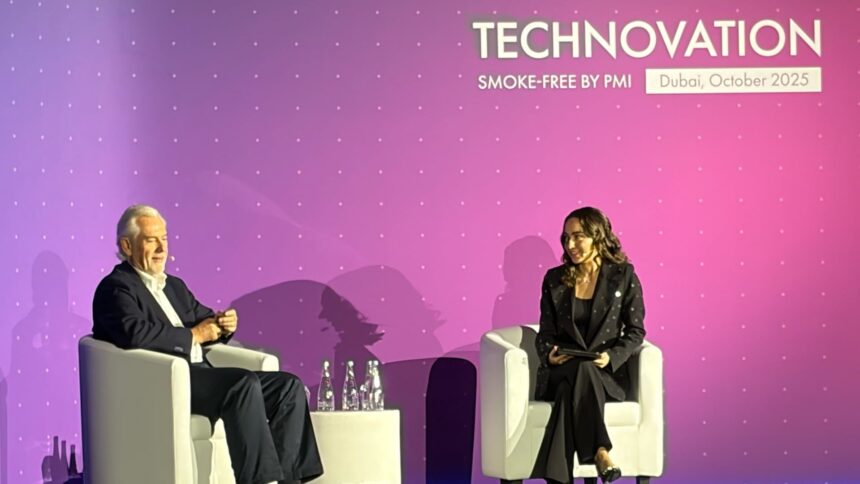Once the emblem of the cigarette era, Philip Morris International (PMI) is undergoing one of the most significant business transformations of the 21st century. At the helm is CEO Jacek Olczak, who has made it his mission to steer the company toward a smoke-free future — not just in rhetoric, but in science-backed action.
In a candid conversation with business journalist Maysa Eid at the Technovation 2025 event in Dubai, Olczak explains what it takes to disrupt an industry rooted in decades of habit and controversy. From battling misinformation to navigating outdated regulations, he shares the internal and external challenges PMI faces as it attempts to replace cigarettes with reduced-risk alternatives — and why the global south must be part of the solution.
A Smoke-Free Vision Meets a Misinformed Reality
PMI has spent over a decade investing in technologies designed to reduce the harm of smoking. The company’s flagship product, IQOS, heats tobacco without burning it, cutting exposure to harmful chemicals by up to 95%. But Olczak is quick to acknowledge a sobering truth: technology alone won’t change behavior.
People do smoke — and they will continue smoking if we don’t give them alternatives. Technology gives us a way to reduce harm drastically. But society is not fully ready, or even informed.
He notes that public understanding of tobacco alternatives remains clouded by outdated messaging and misinformation — particularly the persistent idea that nicotine is the root of tobacco-related disease.
Nicotine is addictive, yes. But it’s not the cause of cancer,” he stresses. “It’s the combustion — the burning of tobacco — that releases thousands of toxic chemicals. That’s the problem we’re solving.
Regulation: The Missing Piece in the Innovation Puzzle
Despite the availability of smoke-free products in over 80 markets, Olczak says regulatory systems remain dangerously behind the science. Ten years after PMI launched its reduced-risk portfolio, many governments still either restrict access or ban communication about these alternatives altogether.
Ten years is more than enough time to read the science, verify it, and act,” he argues. “You can finish two degrees in that time.
He points to Japan as a model of progressive regulation. There, more than 50% of smokers have already transitioned to heated tobacco products. Sweden offers another example — with national smoking rates now hovering at just 5%.
These countries didn’t stop telling people smoking is harmful. But they also gave them realistic alternatives. And it worked.
By contrast, in markets where reduced-risk products are either banned or misrepresented, smoking rates have stagnated — or even increased. In Olczak’s view, this divergence underscores the urgent need for regulatory frameworks that both acknowledge the science and empower consumers.
Reframing Nicotine: A New Narrative Is Needed
One of the most persistent barriers to transformation is the stigma around nicotine itself. While nicotine is addictive, Olczak argues that its demonization has distorted public perception — and policy.
If we continue blaming nicotine for the harms of smoking, we’re not just wrong — we’re delaying solutions.
He points to research showing nicotine’s role in mood regulation and cognitive function, such as focus and attention. That doesn’t make it harmless — but it does explain why smokers return to it, and why alternatives must replicate the experience in safer ways.
You can’t ask smokers to give up what they perceive as a benefit without offering a replacement. That’s not how behavior change works.
PMI’s approach is based on harm reduction — not moral judgment. By separating nicotine from the harmful effects of combustion, the company is betting that smokers will make better choices if given credible, science-backed options.
PMI’s Internal Shift: Putting Money Where the Mission Is
Olczak emphasizes that PMI’s transformation isn’t symbolic — it’s structural. Nearly all of the company’s R&D and commercial spending is now dedicated to smoke-free products.
99.5% of our research and development budget supports smoke-free innovation. We haven’t invested in cigarettes for over a decade.
This internal focus extends to how the CEO himself operates.
My day starts with smoke-free, ends with smoke-free — even when I walk my dog,” he jokes. “It’s not a slogan. It’s our operating system now.
Importantly, PMI isn’t treating smoke-free products as a portfolio extension. The strategy is based on substitution, not addition. The goal is not dual-use — it’s full replacement.
Tackling Affordability in the Global South
Ensuring this transformation reaches lower-income countries is non-negotiable, Olczak says. PMI’s mantra — “no smoker left behind” — guides product design, pricing strategies, and market rollout plans.
Affordability barriers are real, especially in the Global South. But through innovation and scale, we’ve reduced costs significantly.
The company is also diversifying its product mix to meet different income levels and consumption preferences. Nicotine pouches, for example, offer a low-cost, low-risk option comparable to nicotine replacement therapies.
If someone prefers inhalation, there’s heated tobacco or vaping. If not, there are pouches. The point is to meet people where they are.
Engagement, Not Exclusion: A Call to Policymakers
One of Olczak’s most pointed critiques is aimed at institutions that refuse to engage with the tobacco industry — even when the conversation is about quitting smoking.
How do you solve the problem of smoking without talking to the people who make the products?” he asks. “It’s like fixing road safety without talking to car makers.
He insists that progress hinges on collaboration — not isolation. In markets where regulators have opened the door to dialogue, public health outcomes are improving.
We all agree smoking is harmful. But repeating that for another 50 years won’t help. Science has given us tools. Let’s use them.
Conclusion
Philip Morris International is not asking for approval — it’s asking for evidence-based action. Under Jacek Olczak’s leadership, the company has aligned its resources, its mission, and its products toward eliminating cigarettes from its business. But systemic change depends on more than innovation.
For this transformation to succeed globally, governments must update their policies, public health leaders must update their messaging, and society must update its assumptions. The technology exists. The science is there. What remains is the collective will to move forward — together.





















